The Wood Duck...a triumph of conservation
September 16, 2013
I made post of the beautiful
The Wood Duck is a perching duck that is quite common in North America.
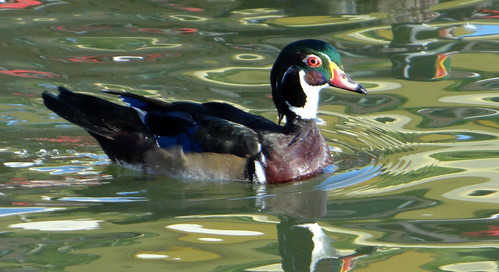 The adult male has distinctive multicoloured iridescent plumage and red eyes,with a distinctive white flare down the neck. The female, less colourful, has a white eye-ring and a whitish throat. Both adults have crested heads.
The adult male has distinctive multicoloured iridescent plumage and red eyes,with a distinctive white flare down the neck. The female, less colourful, has a white eye-ring and a whitish throat. Both adults have crested heads.
 The Wood Duck is slightly smaller than the Mallard.
The Wood Duck is slightly smaller than the Mallard.
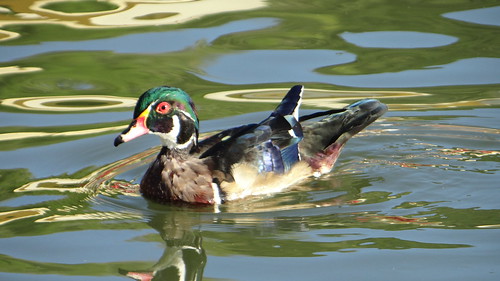 Their breeding habitat is wooded swamps, shallow lakes, marshes or ponds, and creeks in eastern North America, the west coast of the United States and western Mexico. They usually nest in cavities in trees close to water, although they will take advantage of nesting boxes in wetland locations if available.
Their breeding habitat is wooded swamps, shallow lakes, marshes or ponds, and creeks in eastern North America, the west coast of the United States and western Mexico. They usually nest in cavities in trees close to water, although they will take advantage of nesting boxes in wetland locations if available.
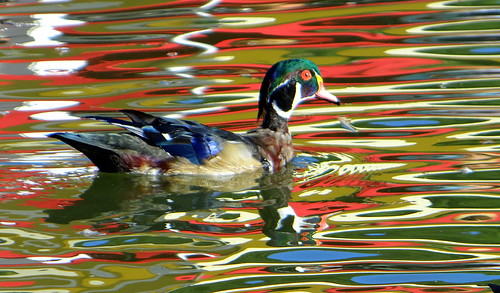 One unusual feature about Wood Ducks is that unlike most other ducks, the Wood Duck has sharp claws for perching in trees.
One unusual feature about Wood Ducks is that unlike most other ducks, the Wood Duck has sharp claws for perching in trees.
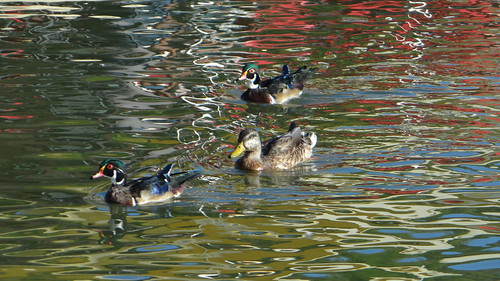 These birds feed by dabbling or walking on land. They mainly eat berries, acorns, and seeds, but also insects, making them omnivores.
These birds feed by dabbling or walking on land. They mainly eat berries, acorns, and seeds, but also insects, making them omnivores.
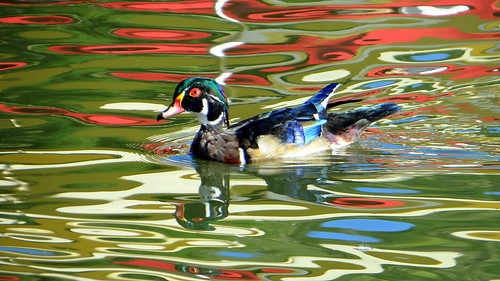 The case of the Wood Duck is a triumph of conservation. The population of the Wood Duck was in serious decline in the late 19th century as a result of severe habitat loss and market hunting both for meat and plumage for the ladies' hat market in Europe. By the beginning of the 20th century Wood Ducks had virtually disappeared from much of their former range. In response to the Migratory Bird Treaty established in 1916 and enactment of the Federal Migratory Bird Treaty Act of 1918, wood duck populations began to recover slowly.
The case of the Wood Duck is a triumph of conservation. The population of the Wood Duck was in serious decline in the late 19th century as a result of severe habitat loss and market hunting both for meat and plumage for the ladies' hat market in Europe. By the beginning of the 20th century Wood Ducks had virtually disappeared from much of their former range. In response to the Migratory Bird Treaty established in 1916 and enactment of the Federal Migratory Bird Treaty Act of 1918, wood duck populations began to recover slowly.
 By ending unregulated hunting and taking measures to protect remaining habitat, wood duck populations began to rebound in the 1920s. The development of the artificial nesting box in the 1930s gave an additional boost to Wood Duck conservation..
By ending unregulated hunting and taking measures to protect remaining habitat, wood duck populations began to rebound in the 1920s. The development of the artificial nesting box in the 1930s gave an additional boost to Wood Duck conservation..


